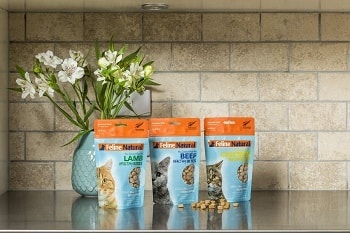
It can be hard to choose the right cat treat for your kitty, though, because there’s an overwhelming number to choose from. That’s where our reviews come in. We’ve looked at dozens and dozens of the healthiest cat treats on the market and selected 10 that we think are the best of the best.
From tasty freeze-dried treats from a single protein source to tempting treats designed to help your cat’s skin and fur look and feel their best, you’re sure to find the perfect cat treat in our roundup.
Our Top Picks of 2024
| Image | Product | Details | ||
|---|---|---|---|---|
| Best Overall |
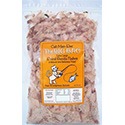
|
Cat-Man-Doo |
|
CHECK PRICE |
| Best Value |
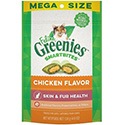
|
Greenies SmartBites |
|
CHECK PRICE |
| Premium Choice |
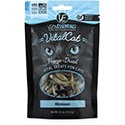
|
Vital Essentials Minnows |
|
CHECK PRICE |
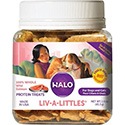
|
Halo Liv-a-Littles |
|
CHECK PRICE | |
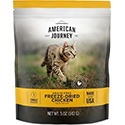
|
American Journey |
|
CHECK PRICE |
The 10 Best Cat Treats
1. Cat-Man-Doo Extra Large Dried Bonito Flakes — Best Overall

As the overall best cat treats, we chose the Cat-Man-Do Extra Large Dried Bonito Flakes. Made from pure dried Bonito fish flakes, these treats are an excellent choice for cats who are on a calorie-controlled diet, as they only contain 5 kcals per serving. While these flakes might be low in calories, they’re rich in protein, taurine, and natural fish oils.
These all-natural cat treats can be used during training sessions with your cat sprinkled over their kibble or wet food to increase palatability, or simply given as a treat when you feel like spoiling your cat! These flakes by Cat-Man-Doo have plenty of positive reviews; in fact, some cats seem to love them so much that they’re sad when these treats run out!
- Choose from three bag sizes
- Only 5 kcals per serving
- Single protein source
- No additives or preservatives
- Limited ingredients
- Larger flakes need breaking in two
2. Greenies Feline SmartBites — Best Value

If you’re looking for the best healthy cat treats for the money, then look no further than the Greenies Feline SmartBites! These treats not only taste good but are also formulated with plenty of natural ingredients to help your cat look and feel their best. These treats are specifically designed to improve the health of your cat’s fur and skin.
These treats won’t interfere with your cat’s diet either, coming in at less than 2 calories per treat. They’re packed full of fish oil and flaxseeds, which, in combination, provide a rich source of omega-3 fatty acids, plus plenty of vitamins and minerals. The dual texture features a crunchy outer and a soft chicken-flavored center. The only reason these missed out on the top spot on this list is that they aren’t quite as palatable to all cats, but they are one of the healthiest cat treats out there.
- Choose from two bag sizes
- Contain no fillers
- Free from preservatives
- No artificial flavorings
- Some cats don’t like the taste
3. Vital Essentials Minnows Freezelink-Dried Cat Treats — Premium Choice

As our premium choice of healthy cat treats, we selected the Vital Essentials Minnows Freeze-Dried Cat Treats. These might be a little more expensive than your average treat, but they’re well worth it. Packed with raw meat, each treat is made from raw, then freeze-dried minnow. That means no artificial flavorings, by-products, or fillers—just pure goodness!
If the source of origin is important for you when selecting the best cat treats, then you can’t do any better than these. Not only are the treats processed and packaged in the U.S.A., but the minnows are also wild-caught in Minnesota and Wisconsin. So, you know your cat is getting locally sourced goodness. The only reason that we didn’t select these natural cat treats for the top two spots on our list is that they are pricey.
To conclude, these are our premium choices for the best healthy treats for cats.
- Single protein source
- Made in the U.S.A.
- Low in fat
- No fillers or preservatives
- Some cats need to get used to these treats
- Related Read: 10 Best Cat Foods Made in U.S.A. – Reviews & Top Picks
4. Halo Liv-a-Littles Grain-Free Cat Treats

The Halo Liv-a-Littles Grain-Free Cat Treats use whole meat protein from wild-caught salmon that has been freeze-dried, not dehydrated. Farm-raised salmon is a definite no when it comes to these treats, as is the use of any artificial preservatives, colors, or flavors. These healthy Halo treats only contain 6 calories each, so they are great to use for cats on a calorie-controlled diet.
These treats come as quite large chunks of pure freeze-dried salmon, so you’ll likely need to break them up into smaller pieces to feed them as a bite-sized treat for your cat. You can also crumble them up to use as a topper over kibble or wet food to tempt a fussy eater.
- Made in the U.S.A.
- Highly digestible
- High in protein
- Needs to be broken into smaller pieces
5. American Journey Chicken Freeze-Dried Grain-Free Cat Treat

The American Journey Chicken Freeze-Dried Grain-Free Cat Treat is a great choice if you’re looking for a healthy chicken-based treat for your cat. Containing only free-dried chicken, these treats contain loads of nutrients and flavor, all designed to help your cat feel and look great.
If your cat has food allergies, then these treats are a great choice because they only contain one ingredient: real chicken. There is no soy, chicken meal, filler, carrageenan, wheat, salt, preservative, sugar, or corn here! The freeze-drying process preserves all the freshness and taste of chicken that your cat will love. Plus, at only 3 calories per treat, you don’t need to worry about affecting your cat’s diet!
- High in protein
- Grain-free
- Made in the U.S.A.
- Expensive
6. Blue Buffalo Wilderness Grain-Free Cat Treats
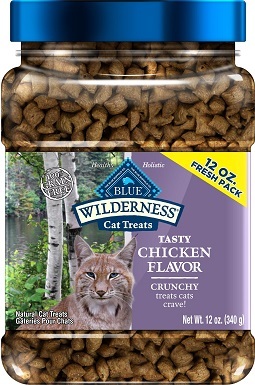
The Blue Buffalo Wilderness Grain-Free Cat Treats are an excellent choice if you’re looking for a small, tasty, and healthy treat option. At only 1.3 calories per treat, these are a great choice to use during training sessions or to reward your cat simply for being awesome!
While they do contain real chicken as the first ingredient, they also contain chicken meal, which some cat owners may want to avoid. Cats do seem to enjoy these crunchy little treats, but they are quite small, so some cats will gobble them up a bit too quickly.
- Available in two sizes
- Grain-free
- Made in the U.S.A.
- Contains chicken meal
- Long ingredient list
7. Hill’s Prescription Diet Metabolic Weight Management Cat Treats
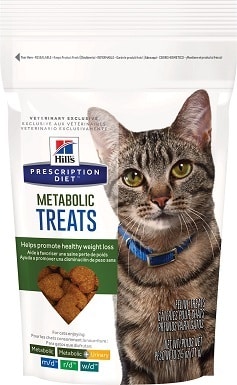
If your cat is on a strict calorie-controlled diet, then it can be a challenge to find a healthy cat treat that’s low in calories. In this case, Hill’s Prescription Diet Metabolic Weight Management Cat Treats are a perfect choice. As well as being extremely tasty, these treats help keep your cat feeling fuller for longer. This way, they won’t be hanging around their food bowl waiting for the next meal!
What we don’t like about these treats is that they have chicken by-products as the first ingredient, which is something many cat owners try to avoid. They also contain natural flavors (good) and artificial flavors (bad). You’ll also need to request authorization for these treats from your veterinarian.
- Ideal for cats on a diet
- Only 1 calorie per treat
- Contain chicken by-products
- Long ingredient list
- Requires veterinary authorization
8. Bravo! Healthy Bites Salmon Freeze-Dried Cat Treats
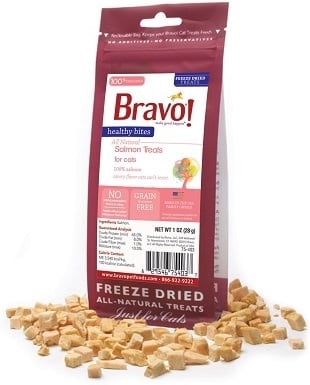
The Bravo! Healthy Bites Freeze-Dried Cat Treats are made from pure salmon, so they’re a good choice if your cat has allergies and you want to avoid a long list of ingredients. They contain no artificial preservatives, flavorings, or colors. They’re high in protein, with a minimum of 65% protein per treat.
The freeze-drying process helps retain flavor along with nutrients, meaning your cat will keep coming back for more treats. While the calorie content per bag is stated, this isn’t broken down into a per-treat analysis. That means it will be harder to calculate your cat’s daily rations if you’re using these as part of a calorie-controlled diet plan.
- Made in the U.S.A.
- Grain-free
- Not suitable for kittens
- Calorie content not stated
9. PetKind Grain-Free Green Bison Tripe Cat Treats
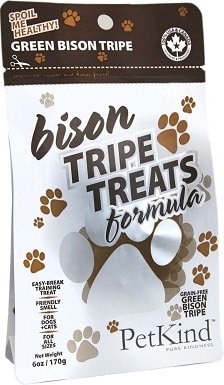
The PetKind Grain-Free Green Bison Tripe Cat Treats are packed full of green bison tripe and chicken, making them irresistible to your cat. Tripe is part of the stomach lining of herbivores, and while that can sound yucky, it’s a good ingredient for helping absorb excess stomach acid.
Because these treats are designed for both cats and dogs, they’re a little bigger than your average cat treat. That means you’ll need to break them apart to feed them to your cat. They also have a strong meaty smell and a slightly oily texture, so if you’re a little sensitive or squeamish in that department, then bear that in mind!
- Contain omega-3 and -6 fatty acids
- Grain-free
- Expensive
- Need to be broken apart
- Contains smoke flavoring
- Strong smell
10. Feline Natural Lamb Healthy Bites Grain-Free Cat Treats
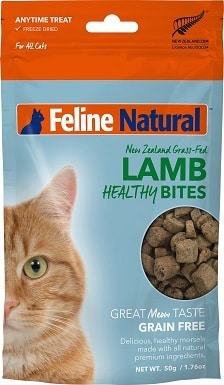
Feline Natural Lamb Healthy Bites Grain-Free Cat Treats are high-protein and grain-free healthy treats made with a blend of freeze-dried lamb meat and organs. As they only contain one protein source, lamb, and no other ingredients, these are a good choice for cats on a limited-ingredient diet or those suffering from allergies.
Despite being a freeze-dried treat, the texture of these is soft rather than dry and chewy. That, plus the small size of these treats, means your cat can eat them a little too quickly. But we still think these are some of the best treats for cats available this year, and they’re healthy cat treats, too.
- Only 3 calories per treat
- Expensive
- Non-U.S.A. meat
- Small size
- Some cats don’t like the soft texture
Buyer’s Guide: Picking the Healthiest & Best Cat Treats
When you start your hunt for the best healthy cat treats for your own feline, the first thing to decide is what type of cat treat you’ll choose.
- Freeze-dried treats. These are usually made from either one animal protein source or a blend of a few different sources. Other than animal protein, they don’t generally contain anything else, so they’re a great choice if your cat has allergies or they’re on a limited-ingredient diet. Freeze drying helps retain all the vitamins, minerals, and natural goodness of real meat.
- Dry treats. These are the “typical” cat treats and contain a blend of ingredients that are then shaped. These come in a huge range of flavors and types, so if you’re looking for a tuna-flavored low-calorie treat, you’re bound to find one to fit the bill!
- Soft treats. These have a higher moisture content than other treats and a softer texture that can appeal to some cats. Senior cats who have trouble crunching dry treats do seem to prefer softer treats.
- Multi-texture treats. Some treats have a soft center surrounded by a crunchy outer shell. If your cat can’t decide which texture they prefer, then try a treat with both!
- Specialty treats. Some treats are designed for cats with specific dietary requirements, for example, a calorie-controlled diet or one with no grain or low protein. Just because your cat has specific dietary requirements doesn’t mean you won’t be able to find a treat to suit them! Some specialty treats will require veterinary authorization before you can buy them. This is as simple as providing your vet’s details to the online retailer.
Ingredients to watch out for
When choosing the best cat treats for your cat, be sure to take a look at the ingredients list. While there aren’t any specific ingredients you need to avoid across the board, there might be certain ones that you don’t want your cat to eat.
- Meat by-products. Some treats contain meat by-product meal, and if you make an effort to avoid this in your cat’s usual feed, then it makes sense to do the same when it comes to the treats you feed them.
- Artificial flavors and colors. It’s a good idea to try and steer clear of treats with too many artificial colors and flavors. While they might make a treat seem super palatable to your cat, they won’t be doing them any good, either. If you see “natural flavor” listed, be aware that this isn’t as much of a natural product as the name suggests. It’s a highly concentrated additive made from animal tissue. It’s added to treats to make them irresistible to your cat and can sometimes cover up the fact that there isn’t much goodness in the treat at all.
Why does a cat treat need to be healthy?
You might think that all cat treats are created equal and that it might not matter which packet you choose to grab from the grocery store. That’s not the case at all. Cat treats contain calories, and if you’re not carefully monitoring the number of treats your cat gets per day, then those calories can soon add up.
That’s not a major problem if your cat is lean and healthy, but if your cat is on a calorie-controlled diet, then you’ll soon start to see them gaining weight. Whatever treat you choose to feed, make sure to account for it when calculating your cat’s daily rations. This might mean reducing the amount of kibble or wet food you give them to compensate for the additional calories from the treats you use throughout the day.
Many of us also spend plenty of time and energy sourcing the best cat food for our kitties, making sure they contain only the best ingredients. But if we don’t use the same system when selecting cat treats, then we may be exposing our cats to meat by-products, flavorings, and preservatives that we avoid in their usual food.
By choosing a healthy cat treat, possibly even an organic cat treat, makes it easier to give your cat treats without worrying about what they contain or that they’re going to affect your cat’s weight.
Conclusion
That’s a wrap! We hope that by now, you’ve got a good idea of the best healthy cat treat to suit your pampered kitty. As a reminder, we chose the Cat-Man-Do Extra Large Dried Bonito Flakes. These contain only one protein source, bonito fish, and nothing else at all. Cats love the strong fishy taste of these flakes, and at only 5 kcals per serving, you can afford to spoil your cat without running their diet. These flakes can be given whole or crumbled on top of your cat’s dinner for a special treat.
As our best healthy cat treats for the money, we selected the Greenies Feline SmartBites. These low-calorie treats are only 2 kcal each and have a double texture to make them more appealing. They’re packed full of ingredients designed to help keep your cat’s skin and fur in the best condition.
We hope that you’ve found our reviews helpful in finding the best cat treats that are healthy and tasty to suit your cat. We’re sure your cat will let you know if you made the right decision!
Contents
- Our Top Picks of 2024
- The 10 Best Cat Treats
- 1. Cat-Man-Doo Extra Large Dried Bonito Flakes — Best Overall
- 2. Greenies Feline SmartBites — Best Value
- 3. Vital Essentials Minnows Freezelink-Dried Cat Treats — Premium Choice
- 4. Halo Liv-a-Littles Grain-Free Cat Treats
- 5. American Journey Chicken Freeze-Dried Grain-Free Cat Treat
- 6. Blue Buffalo Wilderness Grain-Free Cat Treats
- 7. Hill’s Prescription Diet Metabolic Weight Management Cat Treats
- 8. Bravo! Healthy Bites Salmon Freeze-Dried Cat Treats
- 9. PetKind Grain-Free Green Bison Tripe Cat Treats
- 10. Feline Natural Lamb Healthy Bites Grain-Free Cat Treats
- Buyer’s Guide: Picking the Healthiest & Best Cat Treats
- Conclusion













